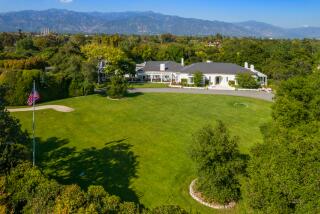Birthplace of San Marino Is Up for Sale for a Mere $2.9 Million
- Share via
The house where San Marino was born--a mansion to match the vigor and vision of one of the city’s founding families--is for sale.
One of the earliest and largest homes in a city noted for its many sprawling estates, the house built by George Smith Patton Sr. is on a knoll overlooking its neighbor, the Huntington Library, Art Collections and Botanical Gardens. Yet it is likely that many San Marino residents have never noticed it and know little of its place in local history.
Patton and Henry E. Huntington secretly plotted San Marino’s incorporation in a basement room of the house when neighboring cities threatened to annex their prosperous farms in 1913.
Later that year, San Marino’s first City Council meeting was held in the house, and Patton became the city’s first mayor.
Patton’s son and namesake, who would become the flamboyant U.S. Army general, graduated from the U.S. Military Academy at West Point in 1909, when the house was being built. Throughout his life, Patton Jr. kept special quarters for his family on the second floor and sometimes brought his friends, Gen. John J. Pershing and Gen. James Doolittle, to visit.
Anne Patton, the general’s unmarried sister, was the last member of the Patton family to live in the house. The home, originally surrounded by 13 acres, remained virtually unchanged as long as she lived there. She moved in with her parents at age 23 in 1910 and died there in 1971.
A developer who bought it after her death sold all but 1 1/2 acres for new homes that now surround the old mansion, obscuring it from view to all but those who venture up the knoll along Patton Way and into Patton Court.
The house was bought in 1973 by Dr. and Mrs. Earl Snodgrass, the only non-Pattons to have lived in it.
“Basically, it is a house that was meant to live forever,” Anne Snodgrass said.
“It’s built like the Mormon Temple,” said Midge Sherwood, who has written three books on San Marino’s history and is an authority on its fine old houses.
A newspaper advertisement says that buying the Patton house--for $2.9 million--is “an opportunity to own a part of the history of our country,” proclaiming it a “magnificent traditional manor house, a historic and regal landmark maintaining its old world charm and integrity.”
The senior Patton may have had such grand aspirations 80 years ago, when he began planning the house. A lawyer who Sherwood described as “serious” and having a taste for politics, Patton was Los Angeles County district attorney in 1885 when George Jr. was born. After building his 20-room mansion, Patton Sr. ran for the U.S. Senate and lost.
The house once had a wide brick stairway leading down to Euston Road. One architect has called the design, by Joseph J. Blick of Pasadena, “early Californian with an English accent.”
The house is three stories high and has 8,000 square feet. It has thick walls, the original slate roof with broad eaves, a massive teak front door with a carved design of olive leaves, seven bedrooms, seven fireplaces and floor-to-ceiling walnut paneling in the living room that is “as beautiful as the day it was put on,” according to Anne Snodgrass.
Snodgrass said the reason it changed so little is because Anne Patton simply liked it the way it was from the time she moved in at the age of 23 until she died at 84.
“Elderly people like to have everything stay the same,” Snodgrass said.
She and her husband did some restoration, keeping the house close to its original condition and even duplicating some of the early wallpaper.
The brick stairway down the hill is gone, and all that can be seen of the house from Euston Road is a small portion of the slate roof.
“Now it needs a young family,” said Snodgrass, whose three sons grew up there but are now gone. “It’s a wonderful, wonderful house, but taking care of it is a big job.”
More to Read
Sign up for Essential California
The most important California stories and recommendations in your inbox every morning.
You may occasionally receive promotional content from the Los Angeles Times.






